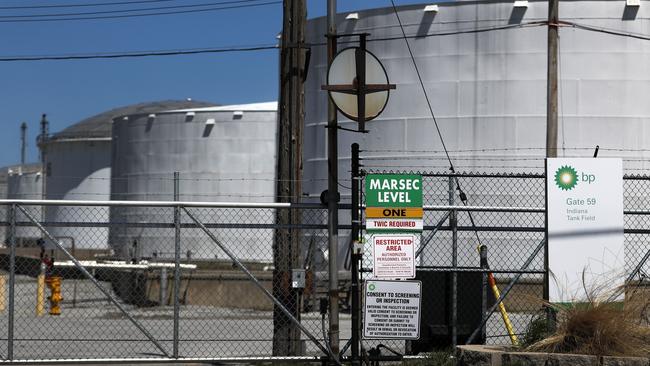Oil price crash deepens
A fresh plunge in oil prices is stinging investors, adding even more urgency to the crisis sweeping the energy industry.

A fresh plunge in oil prices dragged down investments from stocks to currencies, stinging investors anew and adding even more urgency to the crisis sweeping the energy industry.
Major US stock indexes have largely shrugged off concerns about bankruptcies and job losses in the energy sector while rebounding from a March 23 multiyear low. But this week’s drops show that recent chaos in the world’s busiest commodity market is beginning to compound lingering worries about the coronavirus.
TRADING DAY BLOG: Follow all the breaking news
The most heavily traded US crude-oil futures contract tumbled 43 per cent to $US11.57 a barrel, its lowest close in 21 years. Its record low is $US10.42 in data going back to 1983. The tumble came a day after one contract for US crude dropped below zero for the first time in history, forcing sellers to pay buyers to take barrels off their hands.
Brent crude futures, the international benchmark for oil markets, dropped 24 per cent to $US19.33 a barrel, their lowest level in more than 18 years. The US contract for delivery next month, which settled at a historic minus $US37.63 a barrel Monday, rose to expire at $US10.01 in thin trading Tuesday.
Later, in Asia trade, oil recovered ground, with US benchmark West Texas Intermediate for June delivery rising 18.93 percent to $US13.76 a barrel. European benchmark Brent crude for June delivery was up 0.98 percent at $19.52 a barrel, after tumbling to an 18-year low the previous day.
Anxiety about the crash’s impact on large energy producers from the US to Saudi Arabia helped drag the S&P 500 down 3.1 per cent, bringing the broad equity gauge’s fall for the week to nearly 5 per cent. It is still up more than 20 per cent from its March low, but traders say the energy sector’s struggles could contribute to further falls.
“The looming question is now how some of these big energy companies are going to stay afloat,” said Mohit Bajaj, director of exchange-traded fund trading solutions at WallachBeth Capital. “People are pointing fingers in the market to the move in oil... It’s a big shift.”
Investors sold everything from energy stocks to currencies of major suppliers like Russia on Tuesday. Analysts expect a big drop in energy-industry spending to amplify the economic fallout from the coronavirus, with factories shut, streets empty and consumers unable to take advantage of low fuel prices.
Energy producers have lost hundreds of billions of dollars in market value this year, and shares fell again. Royal Dutch Shell and BP lost at least 3 per cent, as did some US companies. Speculation about bankruptcies and possible mergers in the industry is driving wild stock-price swings, and possible issues with energy loans could ripple to the banking industry.
There is little producers can do now. They are unable to shut wells fast enough, and supply cuts by the Organization of the Petroleum Exporting Countries and other nations have come too late. Texas regulators declined to act on a proposal to limit state oil supply, but some shale producers are already being forced to shut in productive wells.
Traders say that even with those steps the world is running out of space to store oil, driving prices below $0 a barrel for the first time on Monday.
“Traders just capitulated to the fact of the limited access to storage,” said Eelco Hoekstra, chief executive of Royal Vopak, a Dutch firm that runs 66 terminals for storing commodities around the world. “It’s been brutal.”
Vopak has already rented out almost all of its oil terminals, Mr Hoekstra added.
“Whatever oil analysts and oil traders have learned over the course of the last 50 years or 100 years was all of a sudden put in question” by Monday’s negative oil prices, said Eugen Weinberg, head of commodities research at Commerzbank. “Everyone has been shocked.”
The plunge has burned individual investors who had poured money into United States Oil Fund LP as they bet on a revival in oil prices in recent weeks. The popular exchange-traded fund tumbled 25 per cent Tuesday, taking its rout this year to nearly 80 per cent. The company that operates the ETF is reshaping it for now into what will effectively be a closed-end fund with a fixed number of shares and fewer near-dated crude futures contracts.
Oil futures, used by investors to bet on the direction of prices and by producers to protect against market swings, had performed better than the physical oil market for several weeks. Now, they are being stung by the slide in demand for actual barrels of crude.
“This is the market signaling to producers that you need to cut off more production faster because we’re drowning in oil at this point,” said Saad Rahim, chief economist at Swiss commodities trader Trafigura.
The dent to global economic activity could now last longer than lockdown measures to slow the pandemic, traders say. Growth in countries like Russia and Mexico is already suffering from lower oil prices, dragging down those nations’ currencies.
Estimates for how much supply will be curtailed pale in comparison to the demand destroyed by the pandemic, leaving energy producers facing an existential threat.
“Demand is contracting two or three times as fast as supply,” said Bob McNally, president of consulting firm Rapidan Energy. The drop in prices is a “brutal but efficient” mechanism to “persuade producers to keep oil under the crust,” Mr McNally said.
Monday’s price moves make it more likely that President Trump will impose tariffs on oil imports into the US, added Mr McNally, a former White House adviser.
Mr.Trump in a tweet Tuesday said he had directed the Energy and Treasury departments to craft a plan to make funds available for the oil-and-gas industry. “We will never let the great U.S. Oil & Gas Industry down,” he wrote.
We will never let the great U.S. Oil & Gas Industry down. I have instructed the Secretary of Energy and Secretary of the Treasury to formulate a plan which will make funds available so that these very important companies and jobs will be secured long into the future!
— Donald J. Trump (@realDonaldTrump) April 21, 2020
Market mechanisms that might help address the slump appear to be breaking down because of the lack of storage space.
Typically, low US prices would encourage traders to buy cheap American oil and sell it at a higher price in Europe or Asia. The way Brent crude prices sank in tandem with WTI on Tuesday suggests “the world doesn’t want to take U.S. barrels,” said Vincent Elbhar, co-founder of Swiss hedge fund GZC Investment Management.
Recent moves also prompted discussions between Saudi Arabia and other members of OPEC about whether to cut production immediately. OPEC members are considering bringing forward the start date for production cuts from May 1.
“We have to face up to the reality that despite OPEC’s pledge, a lot of May cargoes have already been committed,” said Harry Tchilinguirian, head of commodities research at BNP Paribas. In effect, he said, “the cuts will only start to happen in June.”
US oil companies including Chevron Corp. and ConocoPhillips have said they would reduce output. But traders say the industry isn’t moving fast enough to alleviate the selloff. This week’s price moves will be a huge wake-up call for complacent oil-company chiefs, said Edward Marshall, a commodities trader at Global Risk Management.
“If they do nothing and sit there like rabbits in the headlights waiting to be hit by a car, they’ll be hit,” he said. “I wouldn’t be surprised to see even more [capital expenditures] cuts...even more layoffs, even more jawboning by OPEC,” Mr. Marshall added. “It’s got serious now.”
Dow Jones Newswires




